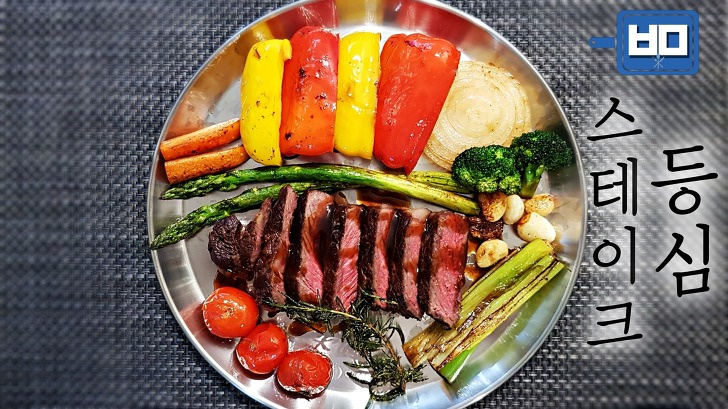Perfect Steak Grilling: The Secret to Restaurant-Quality Steak at Home
Try grilling your steak like this, and you’ll have a luxurious steak right on your dining table!

I’m here to reveal the truth about beef juice preservation and explain how to grill the best steak possible right in your own home. Those who say to sear meat on high heat to ‘trap the juices’ – delete those restaurants from your foodie list. Seriously.
Main Ingredients- 450g Beef sirloin (thick cut recommended)
- A little cooking oil (recommendable: grapeseed or canola oil)
- Coarse salt
- 50g Butter
- 1-2 sprigs fresh thyme
- 1-2 sprigs fresh rosemary
- Steak sauce of your choice
Garnish Ingredients- 10 Cherry tomatoes
- 10 Whole garlic cloves
- 4 Asparagus spears
- 2 Bell peppers (use various colors for visual appeal)
- Broccoli (to taste)
- Onion (to taste)
- Carrot (to taste)
- Green onion (to taste)
- 10 Cherry tomatoes
- 10 Whole garlic cloves
- 4 Asparagus spears
- 2 Bell peppers (use various colors for visual appeal)
- Broccoli (to taste)
- Onion (to taste)
- Carrot (to taste)
- Green onion (to taste)
Cooking Instructions
Step 1
The most universally sought-after steak doneness is ‘medium-rare’. This is because it effectively kills harmful bacteria while maximizing the steak’s natural juices. If you’re aiming for a juicy steak, medium-rare is the way to go!

Step 2
Try the dry-brining method. Generously salt the surface of a thick steak and refrigerate it for about a day. This will dry out the surface, creating ideal conditions for a rich Maillard reaction. If a full day of aging isn’t possible, ensure you salt the meat at least 40 minutes before cooking. Osmosis causes moisture to draw out to the surface within 3-4 minutes of salting, forming brine droplets. It then takes at least 40 minutes for this brine to reabsorb back into the meat. If you’re in a rush, simply salt the steak right before grilling.

Step 3
Gently pat the surface of the steak dry with paper towels to remove any excess moisture. A dry surface is crucial for achieving a beautiful, crispy sear.

Step 4
Heat a pan over high heat until very hot. Add a generous amount of cooking oil. Oil helps conduct heat evenly across the food. High smoke point oils like grapeseed or canola are recommended. Once the oil begins to shimmer and produce faint wisps of smoke, carefully place the steak into the pan.

Step 5
To achieve medium-rare, we’ll cook for a total of about 3 minutes. We’ll start with a 30-second sear on each side, totaling 1 minute of intense searing. After this initial minute, reduce the heat to medium and begin cooking the interior. Since the steak is thick, alternate flipping it every 30 seconds to ensure even cooking.

Step 6
After 3 minutes of cooking, remove the steak from the pan and set it aside. Reduce the heat to low, then add the butter and fresh herbs (thyme or rosemary) to the pan with the remaining oil. This will create an aromatic butter to baste the steak with.

Step 7
Tilt the pan slightly so the direct heat is not on the steak. Spoon the melted butter over the top of the steak for 1 minute, slowly cooking the interior while infusing it with flavor. After 1 minute, flip the steak and repeat the basting process on the other side for another minute.

Step 8
Once cooked, transfer the steak to a plate or loosely tent it with foil and let it rest for 5 minutes. Directly cutting into a steak that has been exposed to high heat will cause its juices to escape rapidly. During this resting period, the heat lowers, allowing the contracted muscle fibers to relax. This process allows the juices to redistribute throughout the meat, resulting in a more tender and moist steak with less juice loss when sliced.

Step 9
While the steak rests, use the remaining butter and rendered fat in the pan to cook your desired garnishes over medium heat. The browned bits at the bottom of the pan are not burnt but are the delicious byproducts of the Maillard reaction, adding flavor to your vegetables. Roast cherry tomatoes, bell peppers, asparagus, garlic, and green onions until they are tender and slightly caramelized.




